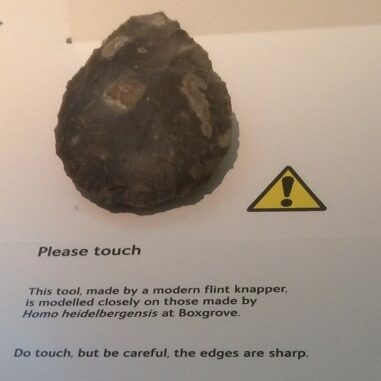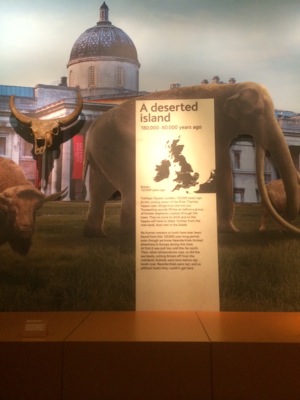
How well do you know your ancestors? You’ve probably got a few black and white photos of great-great uncle Bob and maybe a few daguerreotypes of chaps with large beards who emigrated to America and were never heard of again. But what about before then? What about 100,000 years ago? What about a million years ago? To find that out you can’t ask your grandmother. I suppose you could but it would sour inter-generational relationships.

Kids, don’t ask your grandparents if they remember neanderthals…
Instead visit the new exhibition at the Natural History Museum in South Kensington. Drawing on more than 10 years of research by a 50-strong team of archaeologists, palaeontologists and geologists, Britain: One Million Years of the human story is a temporary exhibition which looks at the dramatic story of ancient Britain and the people who lived here before us.

Of course it wasn’t just people. Even Trafalgar Square, where you would have thought people must have been promenading and busking since before the world began was once home only to wild beasts. Security at the National Gallery must have been very tight.
Four human heads are the first thing the visitor to the show sees. Not real ones but plaster casts, demonstrating the difference in appearance between our predecessors and the all-conquering (at least so far)homo sapiens. An informative timeline of One million years of the human story links the changing climate to the different species of humans that have tried to survive in these bitterly cold islands. Some might ask why they bothered when the Cote d’Azur was available without residency issues or the need to learn French, but bother they did. One thing led to another and here we all are today. As Professor Chris Stringer, world-leading human origins researcher comments, ‘Britain has one of the richest yet most underappreciated records of early human history in the world’. This exhibition aims to change that and bring attention to some of Britain’s earliest history.
And does it start early. On this timescale1066 is only yesterday. For example the exhibition includes one of the oldest wooden tools in the world – a fire-hardened spear point from Clacton, Essex. This is 400,000 years old! That seems pretty ancient, until you notice the Happisburgh pinecone. Found in Norfolk this is a whopping 1 million years old. It is important as it shows that a coniferous forest was growing back then and thus helps to create a picture of the climate and environment. As you can imagine you aren’t allowed to touch any of these artefacts, but there are several displays that include items that aren’t in glass boxes and can be handled.

There are also specially commissioned (no-touch) Neanderthal and Homo sapiens models that are the most scientifically accurate ever made. Also films of the personal ancestries of Bill Bailey, Clive Anderson and others which help tell the unexpected ethnic diversity of modern Britons like us. Judging by the results oftheir scientifically analysed backgrounds your family probably hasn’t always lived in Staines.
Learn how immigration to this scepter’d isle is nothing new, having begun 950,000 years ago, before the sceptre was even invented. And before Britain was even an Isle. Read how animal remains can be used as indicators of climate and environment. Examine the migratory patterns of early humans. You’ll come out knowing a lot more than when you went in about your early ancestors.
Until 28th September 2014

Leave a Reply